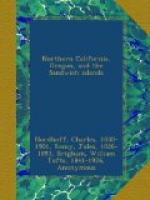The planters err, I think, in not planting the mountain sides, wherever these are accessible and have soil, with trees. The forests of the country are rapidly disappearing, especially from the higher plains and the grass-bearing slopes. Not only is the wood cut for burning, but the cattle browse down the young growth; and a pestilent grub has of late attacked the older trees and destroyed them in great numbers. Already complaints are heard of the greater dryness and infertility of certain localities, which I do not doubt comes from suffering the ground to become bare. At several points I was told that the streams were permanently lower than in former years—of course because evaporation goes on more rapidly near their head waters now that the ground is bare. But little care or forethought is exercised in such matters, however. A few extensive plantations of trees have been made, notably by Captain Makee on Maui, who has set out a large number of Australian gum trees. The universal habit of letting cattle run abroad, and the dearness of lumber for fencing, discourages tree planting, which yet will be found some day one of the most profitable investments in the islands, I believe; and I was sorry to see in many places cocoa-nut groves dying out of old age and neglect, and no young trees planted to replace them.
It remains to describe to you the “contract labor” system by which the sugar-plantations are carried on. This has been frequently and, as it seems to me, unjustly abused as a system of slavery. The laborers hire themselves out for a stated period, usually, in the case of natives, for a year, and in the case of Chinese for five years. The contract runs in English and in Hawaiian or Chinese, and is sufficiently simple. Thus:
“This Agreement, made and entered into this —— day of ——, A.D. 18—, by and between the owners of the —— plantation, in the island of ——, party of the first part, and —— ——, party of the second part, witnesseth:
“I. The said party of the second part promises to perform such labor upon the —— plantation, in the district of ——, island of ——, as the said party of the first part shall direct, and that he will faithfully and punctually perform the same as becomes a good workman, and that he will obey all lawful commands of the said party of the first part, their agents or overseers, during the term of —— months, each month to consist of twenty-six working days.
“II. The party of the first part will well and truly pay, or cause to be paid, unto the said party of the second part, at the end of each month during which this contract shall remain in force, compensation or wages at the rate of —— dollars for each month, if said party of the second part shall well and truly perform his labor as aforesaid.”
The law requires that this contract shall be signed before a notary public. The wages are usually eight dollars per month and food, or eleven dollars




